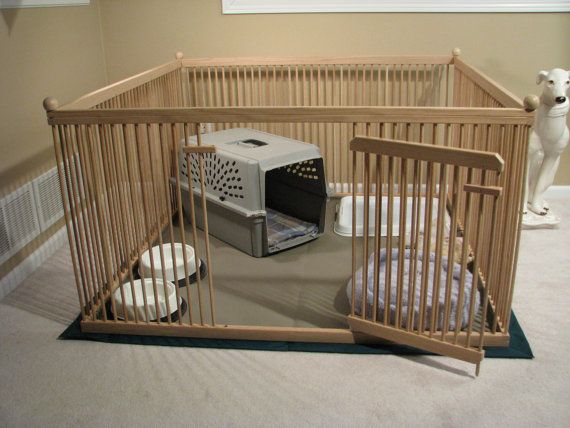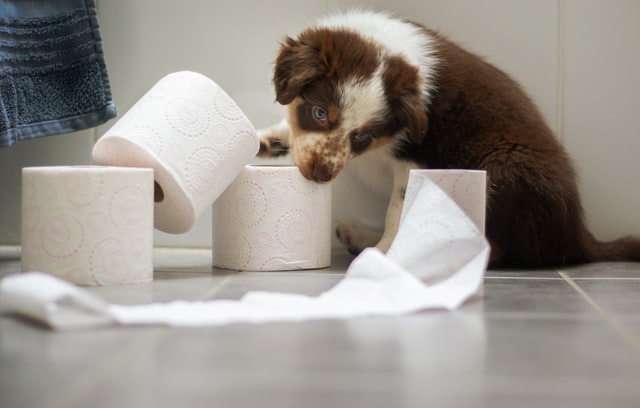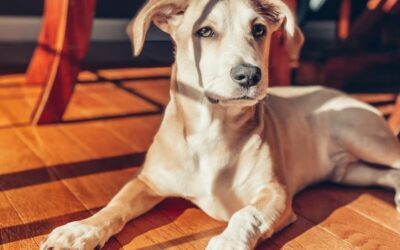Having a new puppy is a fun and joyful time, but there may also be times you find a little overwhelming. House training can often be one of those areas that many new puppy parents find challenging. But you know what… it doesn’t have to be. Following some simple steps can make house training a lot easier for you… and your puppy. The key to successful house training is about prevention, supervision and consistency…. oh, you can also add in patience and lots of positive reinforcement. It’s easier than it sounds… read on for some tips you can use on your house training journey!!
5 STEPS TO SUCCESSFUL HOUSE TRAINING
1. PREVENT ACCIDENTS FROM HAPPENING
Each accident that your puppy has in the house will make training more difficult. When your puppy eliminates – they feel a sense of relief… just like we do when we have to go! That feeling is actually reinforcing to the puppy. So if your puppy eliminates in the house, purely by accident, they still feel sooo much better! They don’t know that the house wasn’t an appropriate place to eliminate. But since it made them feel good, there is an increased likelihood they will continue eliminating in the house.
So, how do you prevent accidents?
Well, the best way is to supervise your puppy and keep on a schedule. A couple of easy ways to ensure your puppy is supervised are:
- Use the umbilical cord method: It’s very much like what it sounds… your puppy is attached to you with a leash. This technique allows you to relax a little bit as you don’t have to always be looking for your puppy… you know where he is… and he can’t sneak off and have an accident.
- Confine them: If you’re not able to supervise your puppy, say you are cooking dinner or talking on the phone, confine them to a crate or small area, such as an X-pen that is set up for their safety.
Not everyone likes crates, I get it, but they really do make house training a lot easier since puppies don’t like to eliminate in their living space. If your puppy is properly crate trained, most will find a crate comforting and safe. One way to help your puppy with crate training is to feed them in their crate, or confinement area. This creates a positive association with the crate as it means they get food… and most puppies love to eat! In order to keep it a positive experience, never use a crate or confinement area as a punishment for your puppy.
The size of the crate you use is also important. If the space is too large you may find your puppy eliminates in one area and sleeps in another. As a guideline for size, a crate should only be large enough for your puppy to lie down, stand up and turn around in. If you purchased a crate to fit your puppy for when they are full grown it may be too big for house training purposes. Don’t fret… you don’t need to buy another crate… just place a barrier in the crate, blocking off a portion, thus reducing the size. Now you are good to go!
2. REWARD ELIMINATION IN APPROPRIATE AREAS
Positive reinforcement increases the likelihood that your puppy will repeat a behavior. It has been proven to be the most powerful and effective way to train dogs.. and that includes house training your puppy.
When you take your puppy outside, use a cue phrase such as “outside” or “let’s go outside”… whatever works for you. Just be consistent and use the same phrase each time. Put their leash on and take them outside immediately (don’t linger or let them sniff… just get them outside) to the area you want them to use for elimination. And yes, even if you have a fenced in backyard you should be using a leash to take them outside. This allows you to monitor whether or not they actually do eliminate and aren’t able to run off behind a bush and you don’t know if they “went” or not. Don’t talk to, or play with them while they are trying to eliminate… they need to focus and puppies are very easily distracted. In the beginning, pay attention to their body language as this can help you learn the signals they may show before they eliminate (i.e. sniffing the ground, circling, etc) which may help you prevent accidents from happening indoors. When it looks like they are going to eliminate, use a cue phrase such as “hurry up”. Again, use this just before they eliminate. This provides the opportunity to train the behavior of eliminating on cue. You may be surprised how often you find that helpful!
Once your puppy is done, provide lots of praise and give them a treat… or three! I mean, make this a HUGE deal! If I could say throw confetti and jump up and down while including your puppy in the celebration, I would. But, that’s not realistic… so just make a big deal about what they did with lots of praise and treats.
At this point, if you are in a secured area, let your puppy off-leash to have some play time. Allowing your puppy play time after eliminating is another form of rewarding them for a job well done. If you take them back inside immediately each time, you may find that your puppy learns to “hold it” rather than eliminate because they want to stay outside. What this can potentially teach them is… eliminating means that fun, outdoor time is over! And they love to be outside, playing, sniffing, etc. So, let them have some fun afterwards! If you happen to be in an area where you can’t have off-leash play… take them for a little walk.
In the event your puppy doesn’t eliminate when you take them out, you can take them back inside… but be sure to supervise or confine them. After about 10 or 15 minutes, try the whole process again.
3. ANTICIPATE WHEN YOUR PUPPY NEEDS TO ELIMINATE
Young puppies have small bladders and they can’t hold their urine for long. A puppy, that isn’t being active, in theory, can hold their urine for about 1 hour plus their age in months. So, a 3 month old puppy may be able to hold their urine for about 4 hours when not being physically active. This however is a general rule of thumb… all puppies will vary and smaller dogs have smaller bladders so may need to go out more frequently. Learn your puppy’s signals and pay attention to them… these time lines are only a guide! Once your puppy reaches about 6-8 months of age they should be able to hold their urine for approximately 8 hours… and this should be the upper time limit for all dogs in general after 7 months of age.
Puppies should always go out after eating, drinking, playing and sleeping… as after each of these activities there is a good chance they will need to eliminate. They should go out first thing in the morning, last thing at night and several times in between… based on the age of your puppy. During the day, if you’re home, take your puppy out frequently whether you think they need to go out or not. Why should you take them out even if they don’t seem to have to go? Well, frequent trips outside gives more opportunities to be successful, and sets your puppy up for success… and the celebration that follows! This is an important part of training. Remember, if you can’t supervise your puppy it’s best to confine them to a crate or small area to help to prevent accidents.
Keeping your puppy on a schedule will make it easier to anticipate when they may need to go out. Feed your puppy at set times, 2 to 3 times a day… giving them about 20 minutes to eat their meal, then picking up their food. Then, within about 10 mins of eating and drinking, at most, take your puppy outside as they will very likely need to eliminate.
To help get through the night – so you get some sleep too – it’s best not to give your puppy any food 2 hours before bedtime. Water however, should be freely accessible to your puppy at all times. If you restrict water during the day, when you do offer it, they will likely drink more. This, in turn, leads to excessive and frequent urination, and will make it much more challenging for you… and it will increase the likelihood that your puppy will have an accident.
You may also find it helpful to keep track of your puppy’s elimination, feeding times and activities. Keeping track of this kind of information will help you to learn your puppy’s routine. There are also apps available for most tablets and phones if you find that method of tracking more appealing.
4. WHAT TO DO WHEN ACCIDENTS HAPPEN
If your puppy has an accident… NEVER punish them… and don’t rub their nose in it! Yelling at, or scolding your puppy for an accident will only accomplish one thing – it teaches your puppy to be afraid of, and not to eliminate in front of you. Think about that! What you are teaching them is that they need to eliminate when you aren’t around! How well is that going to help your house training? Not so much! On top of that, punishment negatively impacts the relationship between you and your puppy. So, leave the punishment at the door…
If your puppy is having an accident, and you catch them in the middle of it, you can interrupt them. Use a cue… I suggest the cue that you use when taking your puppy out… (i.e. “outside”), relatively loudly (without yelling) as this may stop them from eliminating. You now have the opportunity to take them outside and then give lots of praise and treats for eliminating in the proper location. Remember… don’t punish them for having the accident. The truth is… you should have been supervising them!
If you missed your puppy having an accident… move on and see the next step for how to clean the soiled area.
5. CLEAN ACCIDENTS PROPERLY
It’s normal for dogs to be drawn to spots where they, or any dog, have eliminated previously. Any accidents your puppy may have should be cleaned thoroughly with appropriate products. Using the right product prevents further accidents from happening in that location.
Products which contain ammonia, vinegar or bleach should not be used. These types of products can actually attract your puppy back to the area and increase the chances of more accidents. Always use an enzymatic cleaner for cleaning up accidents… both for hard surfaces and for carpets.
LEAVING YOUR PUPPY FOR LONG PERIODS OF TIME

What happens if you have to leave your puppy for a long period of time? Well, I would first ask – can you bring your puppy with you? If you can’t, can someone you know come over and let your puppy out in order to keep up your house training schedule? Or can you hire someone, like a pet sitter or dog walker, to help out?
If none of those are options you can confine your puppy to a large crate, X-pen or small room. Inside the confinement area, or crate, leave your puppy with a spot to eliminate. Keep the elimination area separate from sleeping and eating areas. If your goal is to have your puppy learn to eliminate outdoors, on the grass, a suggestion would be to use a dog litter box and place sod inside of it. You could also use dog litter or newspaper, but using sod is going to make the transition to having your puppy eliminate outdoors so much easier.
Pee pads are another option, but truthfully, I don’t recommend them for puppies. Pee pads can teach your puppy to develop a habit, and an actual preference, to eliminating on objects on the floor such as carpets, clothing, towels, rugs, etc. You will use what you wish, but be prepared for extra challenges if you start using pee pads.
To show your puppy how to use the litter box, put them on a leash, walk them over to the box, use your cue word/phrase, and reward them after they eliminate. This shows them that the litter box is an appropriate place for elimination. It is a better option however, to have someone come in, like suggested above, to let your puppy outside. This will keep up the house training schedule and routine and reinforce that elimination shouldn’t be done in the house.
If you decide to only confine them, without an elimination spot, and it is for longer than they can hold it, they will likely have an accident. Remember, every accident that happens will set back your house training process.
Using the above techniques, most puppies can be successfully house trained. Set your puppy up for success. Be consistent, show patience and provide lots of positive reinforcement. Though this process won’t happen overnight – not unlike toilet training toddlers – putting the work in now saves you a lot of potential frustrations in the long run.
While you’re here, be sure to download our FREE Puppy Socialization Checklist and include socialization outings with your puppy a few times each week. Socialization plays a big role in ensuring your puppy grows into a well-adjusted, happy companion for you and your family.







0 Comments